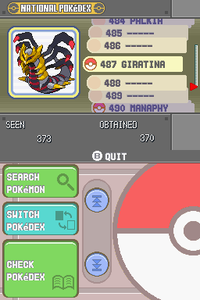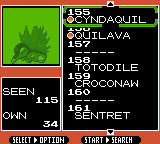How Do U Get the National Pokedex Pokekon Black
From Bulbapedia, the community-driven Pokémon encyclopedia.


Each new generation begins its numbering from the end of the last generation. Cyndaquil, at #155, is the fourth Pokémon introduced in Generation II.
The National Pokédex (Japanese: 全国図鑑 national illustrated encyclopedia) is a Pokédex that has been upgraded with the National Mode (Japanese: 全国版 National Edition) that records information on all Pokémon known to exist, instead of just ones native in a particular region. The National Pokédex is not available at the start of the games, but it can be unlocked by completing certain tasks. Beginning with Generation VII, the National Pokédex is no longer included in the main series games but it can be accessed through storage apps like Pokémon Bank (Version 1.3 and onward) and Pokémon HOME.
In Pokémon Gold, Silver, and Crystal, the equivalent of the National Pokédex order was known as Old Pokédex Mode (Japanese: ふるいずかんモード old-style encyclopedia mode), while Johto's regional Pokédex order at the time was known as New Pokédex Mode (Japanese: しんがたずかんモード new-style encyclopedia mode).
Comparison between generations
- Main article: List of Pokémon by National Pokédex number
In every generation, new Pokémon are added to the National Pokédex. The Pokémon numbers are as follows:
- Generation I Pokémon: #001 Bulbasaur - #151 Mew
- Generation II Pokémon: #152 Chikorita - #251 Celebi
- Generation III Pokémon: #252 Treecko - #386 Deoxys
- Generation IV Pokémon: #387 Turtwig - #493 Arceus
- Generation V Pokémon: #494 Victini - #649 Genesect
- Generation VI Pokémon: #650 Chespin - #721 Volcanion
- Generation VII Pokémon: #722 Rowlet - #809 Melmetal
- Generation VIII Pokémon: #810 Grookey - #898 Calyrex
In the core series
Generation II
In Pokémon Gold, Silver, and Crystal, the Pokédex lists Pokémon by their New Pokédex order (Johto's regional Pokédex) by default. The player has the option to change it to the Old Pokédex order, which is available from the beginning.
Additionally, the Old Pokédex number of any Pokémon is shown in its summary screen (in this generation, the New Pokédex number is not shown in the summary).
Generation III
Generation III introduced the term "National Pokédex".
Pokémon Ruby and Sapphire
In Pokémon Ruby and Sapphire, the Pokédex is upgraded with the National Mode after the game trades with another Generation III game in the core series (except Ruby and Sapphire themselves).
Pokémon Box: Ruby and Sapphire
In Pokémon Box: Ruby and Sapphire, if a game with the National Pokédex is used with Box, Box's Pokédex Mode will be upgraded to the National Mode.
Pokémon FireRed and LeafGreen
In Pokémon FireRed and LeafGreen, if the player has 60 or more Pokémon owned in the Kanto Pokédex, has rescued Lostelle from the Berry Forest and has entered the Hall of Fame, upon talking to Professor Oak in his lab in Pallet Town, he will upgrade both the player's and Blue's Pokédexes with the National Mode.
After obtaining the National Pokédex, the player can obtain Pokémon introduced in Generations II and III via trade and evolution. This allows Generation I Pokémon to evolve into their Generation II forms (such as Golbat being able to evolve into Crobat); prior to obtaining the National Pokédex, these Pokémon will try to evolve but fail. However, the player cannot trade with Pokémon Ruby, Sapphire, and Emerald until they have delivered the Ruby and Sapphire to Celio in the Pokémon Network Center on One Island to put into the Network Machine.
Pokémon Emerald
In Pokémon Emerald, after the player enters the Hall of Fame for the first time, when they exit their house in Littleroot Town after resuming their game, Professor Birch and Brendan or May will be waiting for the player. Birch will escort the two of them to his lab, where he will upgrade both of their Pokédexes with the National Mode.
After obtaining the National Pokédex, the player can trade with any Generation III game, as long as that game has the ability to trade with Emerald. After obtaining the National Pokédex, if the player has collected all 200 non-Mythical Pokémon in the Hoenn Pokédex, Birch will offer the player their choice of one of the Johto starter Pokémon.
Generation IV
Pokémon Diamond, Pearl, and Platinum
In Pokémon Diamond and Pearl, if the player has seen the first 150 Pokémon in the Sinnoh Pokédex, they can obtain the National Pokédex. In Pokémon Platinum, if the player has seen all 210 Pokémon in the expanded Sinnoh Pokédex, they can obtain the National Pokédex. If the player has met the appropriate condition for that game and talks to Professor Rowan in his lab in Sandgem Town, Professor Oak will arrive and upgrade the player's Pokédex with the National Mode.
Pokémon HeartGold and SoulSilver
In Pokémon HeartGold and SoulSilver, after entering the Hall of Fame, when the player attempts to board the S.S. Aqua for the first time, Professor Oak will appear and upgrade the player's Pokédex with the National Mode.
Generation V
Pokémon Black and White
In Pokémon Black and White, after the player defeats Ghetsis at N's Castle and exits their house in Nuvema Town after resuming the game, Cedric Juniper will approach the player, Bianca, and Cheren, then upgrade their Pokédexes with the National Mode.
Pokémon Black 2 and White 2
In Pokémon Black 2 and White 2, after the player enters the Hall of Fame and resumes the game from their house in Aspertia City, Cedric Juniper will visit the player's house and upgrade their Pokédex with the National Mode.
Generation VI
Pokémon X and Y
In Pokémon X and Y, after the player has entered the Hall of Fame, upon entering Lumiose Station, Dexio will upgrade the player's Pokédex with the National Pokédex.
Pokémon Omega Ruby and Alpha Sapphire
In Omega Ruby and Alpha Sapphire, after the player has defeated or caught the super-ancient Pokémon, if they talk to Professor Birch in his lab in Littleroot Town, he will upgrade the player's Pokédex with the National Pokédex.
Unlike most games, non-native Pokémon are obtainable without the National Pokédex; they begin appearing as soon as the player has met the prerequisites to obtain the National Pokédex, regardless of whether they obtain it. Using the PokéNav Plus to attempt to view their Pokédex entries will result in an entry of red text saying that no information is available on the Pokémon, and the areas found display will show "No reported sightings" over the map.
Generation VII
Pokémon Sun, Moon, Ultra Sun, and Ultra Moon
Both Pokémon Sun and Moon and Pokémon Ultra Sun and Ultra Moon do not include the National Pokédex. Pokémon not in the Alola Pokédex do not display any Pokédex number in-game. Pokémon introduced before Generation VII, along with Pokémon introduced in Pokémon Sun, Moon can be used in all four games, and Pokémon introduced in Ultra Sun, and Ultra Moon can be used in those games, but not in Pokémon Sun and Moon.
Pokémon Bank
As part of its version 1.3 update to be compatible with Generation VII, a National Pokédex feature was also added to Pokémon Bank. Bank's National Pokédex is able to display Pokédex entries from any Generation VI or later game. The Pokédex is updated based on the data of any game that is used to connect to Pokémon Bank.
Pokémon Bank's National Pokédex has an extensive search feature, including the ability to filter Pokémon by the games they are naturally available in (not counting the possibility of obtaining a Pokémon by breeding or evolving), as well as the ability to show the Kanto, Johto, "Good Old Hoenn", Sinnoh, Unova, Kalos (divided into Central, Coastal, and Mountain), Hoenn, and Alola Pokédex orders. While the application has since been updated to be compatible with Pokémon Ultra Sun and Ultra Moon, and later, Pokémon HOME, the Pokédex was never updated to include the Pokémon and Pokédex from the former two games.
Pokémon: Let's Go, Pikachu! and Let's Go, Eevee!
As Pokémon: Let's Go, Pikachu! and Let's Go, Eevee! are remakes of Generation I and only feature the first 151 Pokémon, plus Meltan and Melmetal, the National Pokédex is absent. In addition, only the aforementioned Pokémon can be used in game, despite prior games allowing for the use of all Pokémon introduced prior to or introduced in the specified game.
Meltan and Melmetal are registered as #152 and #153 in the Kanto Pokédex, respectively. However, their National Pokédex numbers, #808 and #809, can be seen when using the judge function.
Generation VIII
Pokémon Sword and Shield
Pokémon Sword and Shield does not include the National Pokédex. Only Pokémon in the Galar Pokédex, Isle of Armor Pokédex, Crown of Tundra Pokédex, and a select few other Pokémon can be used in Pokémon Sword and Shield. Pokémon not in the Galar Pokédex do not display any Pokédex number in-game.
Pokémon HOME
Pokémon HOME includes the full National Pokédex. It includes every Pokédex description since Pokémon X and Y, for each Pokémon. Completing the National Pokédex by registering every Pokémon (including all Mythical Pokémon) in HOME rewards the player with an Original Color Magearna, a form which cannot be obtained otherwise.
Pokémon Brilliant Diamond and Shining Pearl
In Pokémon Brilliant Diamond and Shining Pearl, if the player has seen the first 150 Pokémon in the Sinnoh Pokédex, they can obtain the National Pokédex, which only includes the first 493 Pokémon, introduced from Generation I-Generation IV. If the player has met the appropriate condition and talks to Professor Rowan in his lab in Sandgem Town, Professor Oak will arrive and upgrade the player's Pokédex with the National Mode.
In spin-off games
Pokémon Mystery Dungeon series
In Pokémon Mystery Dungeon: Red Rescue Team and Blue Rescue Team, the Pokémon are listed by their National Pokédex number. This applies to the list of Pokémon recruited by the player, and also to the list of Pokémon available when the player is buying Friend Areas from Wigglytuff.
Pokémon Pinball
In Pokémon Pinball, the Pokédex lists Pokémon ordered by their Kanto Pokédex number (which is the same as their National Pokédex number).
Pokémon Trading Card Game series
In Pokémon Trading Card Game, all Pokémon cards have their Kanto Pokédex number (which is the same as their National Pokédex number).
In Pokémon Card GB2: Here Comes Team GR!, almost all Pokémon cards are still native from Kanto, and display their Kanto Pokédex number. The only exceptions are three new Generation II Pokémon cards: Togepi, Marill, and Lugia. They display their Old Pokédex number (175, 183, and 249, respectively).
Pokémon Tetris
In Pokémon Tetris, the Pokédex lists Pokémon ordered by their Old Pokédex number (later known as the National Pokédex).
In the manga
Pokémon Adventures
In Going Green, it was revealed that Professor Oak had requested the Pokédexes back from Red, Blue, and Green in order to upgrade them to National Pokédexes so that they could collect data from other regions. This was accomplished in Secrets from Sneasel, as Oak transferred the data from the old Pokédexes into new ones and inserted a special computer chip into each of them.
Pokémon Diamond and Pearl Adventure!
In Hareta's Future, Mitsumi gave Hareta an upgraded National Pokédex.
In other languages
| Language | Title | |
|---|---|---|
| Chinese | Cantonese | 全國圖鑑 Chyùhngwok Tòuhgaam |
| Mandarin | 全國圖鑑 / 全国图鉴 Quánguó Tújiàn | |
| | Nationaal Pokédex | |
| | Pokédex National | |
| | Nationaler Pokédex | |
| | Pokédex Nazionale | |
| | 전국도감 Jeongukdogam | |
| | Narodowy Pokédex | |
| | National Pokédex | |
| | Национальный Покедекс Natsional'nyy Pokédeks | |
| | Pokédex Nacional | |
| | Từ điển Pokémon toàn quốc | |
See also
- List of Pokémon by National Pokédex number
- Regional Pokédex
- Pokédex
External links
- The Pokémon Company's online Pokédex (Japanese)
- The Pokémon Company International's online Pokédex
- Pokémon Korea's online Pokédex (Korean)
How Do U Get the National Pokedex Pokekon Black
Source: https://bulbapedia.bulbagarden.net/wiki/National_Pok%C3%A9dex